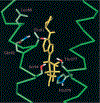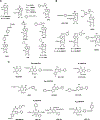International Union of Pharmacology. XXV. Nomenclature and classification of adenosine receptors
- PMID: 11734617
- PMCID: PMC9389454
International Union of Pharmacology. XXV. Nomenclature and classification of adenosine receptors
Abstract
Four adenosine receptors have been cloned and characterized from several mammalian species. The receptors are named adenosine A(1), A(2A), A(2B), and A(3). The A(2A) and A(2B) receptors preferably interact with members of the G(s) family of G proteins and the A(1) and A(3) receptors with G(i/o) proteins. However, other G protein interactions have also been described. Adenosine is the preferred endogenous agonist at all these receptors, but inosine can also activate the A(3) receptor. The levels of adenosine seen under basal conditions are sufficient to cause some activation of all the receptors, at least where they are abundantly expressed. Adenosine levels during, e.g., ischemia can activate all receptors even when expressed in low abundance. Accordingly, experiments with receptor antagonists and mice with targeted disruption of adenosine A(1), A(2A), and A(3) expression reveal roles for these receptors under physiological and particularly pathophysiological conditions. There are pharmacological tools that can be used to classify A(1), A(2A), and A(3) receptors but few drugs that interact selectively with A(2B) receptors. Testable models of the interaction of these drugs with their receptors have been generated by site-directed mutagenesis and homology-based modelling. Both agonists and antagonists are being developed as potential drugs.
Figures




References
-
- Abbracchio MP, Ceruti S, Brambilla R, Franceschi C, Malorni W, Jacobson KA, von Lubitz DK, and Cattabeni F (1997) Modulation of apoptosis by adenosine in the central nervous system: a possible role for the A3 receptor. Pathophysiological significance and therapeutic implications for neurodegenerative disorders. Ann NY Acad Sci 825:11–22. - PMC - PubMed
-
- Ådén U, Leverin A-L, Hagberg H, and Fredholm BB (2001) Adenosine A1 receptor agonism in the immature rat brain and heart. Eur J Pharmacol 426:185–192. - PubMed
-
- Ådén U, Herlenius E, Tang L-Q, and Fredholm BB (2000) Maternal caffeine intake has minor effects on adenosine receptor ontogeny in the rat brain. Pediat Res 48:177–183. - PubMed
-
- Akbar M, Okajima F, Tomura H, Shimegi S, and Kondo Y (1994) A single species of A1 adenosine receptor expressed in Chinese hamster ovary cells not only inhibits cAMP accumulation but also stimulates phospholipase C and arachidonate release. Mol Pharmacol 45:1036–1042. - PubMed
-
- Altiok N, Balmforth AJ, and Fredholm BB (1992) Adenosine receptor-induced cAMP changes in D384 astrocytoma cells and the effect of bradykinin thereon. Acta Physiol Scand 144:55–63. - PubMed
Publication types
MeSH terms
Substances
Grants and funding
LinkOut - more resources
Full Text Sources
Other Literature Sources
Medical
Molecular Biology Databases
